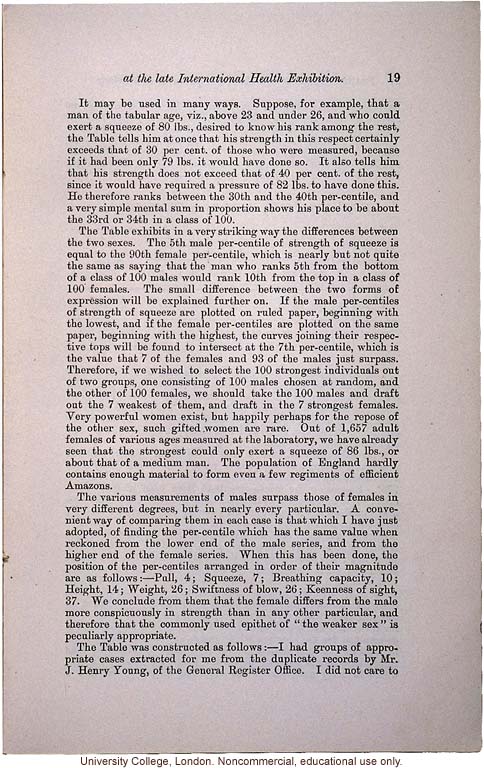at the late International Health Exhibition. 19
It may be used in many ways. Suppose, for example, that a man of the tabular age, viz., above 23 and under 26, and who could exert a squeeze of 80 lbs., desired to know his rank among the rest, the Table tells him at once that his strength in this respect certainly exceeds that of 30 per cent. of those who were measured, because if it had been only 79 lbs. it would have done so. It also tells him that his strength does not exceed that of 40 per cent. of the rest, since it would have required a pressure of 82 lbs. to have done this. He therefore ranks between the 30th and 40th per-centile, and a very simple mental sum in proportion shows his place to be about the 33rd or 34th in a class of 100.
The Table exhibits in a very striking way the differences between the two sexes. The 5th male per-centile of strength of squeeze is equal to the 90th female per-centile, which is nearly but not quite the same as saying that the man who ranks 5th from the bottom of a class of 100 males would rank 10th from the top in a class of 100 females. The small difference between the two forms of expression will be explained further on. If the male per-centiles of strength of squeeze are plotted on ruled paper, beginning with the lowest, and if the female per-centiles are plotted on the same paper, beginning with the highest, the curves joining their respective tops will be found to intersect at the 7th per-centile, which is the value that 7 of the females and 93 of the males just surpass. Therefore, if we wished to select the 100 strongest individuals out of two groups, one consisting of 100 males chosen at random, and the other of 100 females, we should take the 100 males and draft out the 7 weakest of them, and draft in the 7 strongest females. Very powerful women exist, but happily perhaps for the repose of the other sex, such gifted women are rare. Out 1,657 adult females of various ages measured at the laboratory, we have already seen that the strongest could only exert a squeeze of 86 lbs., or about that of a medium man. The population of England hardly contains enough material to form even a few regiments of efficient Amazons.
The various measurements of males surpass those of females in very different degrees, but in nearly every particular. A convenient way of comparing them in each case is that which I have just adopted, of finding the per-centile which has the same value when reckoned from the lower end of the male series, and from the higher end of the female series. When this has been done, the position of the per-centiles arranged in order of their magnitude are as follows: -- Pull, 4; Squeeze, 7; Breathing capacity, 10; Height, 14; Weight, 26; Swiftness of blow, 26; Keenness of sight, 37. We conclude from them that the female differs from the male more conspicuously in strength than in any other particular, and therefore that the commonly used epithet of the "the weaker sex" is peculiarly appropriate.
The Table was constructed as follows: -- I had groups of appropriate cases extracted for me from the duplicate records by Mr. J. Henry Young, of the General Register Office. I did not care to
[end]


